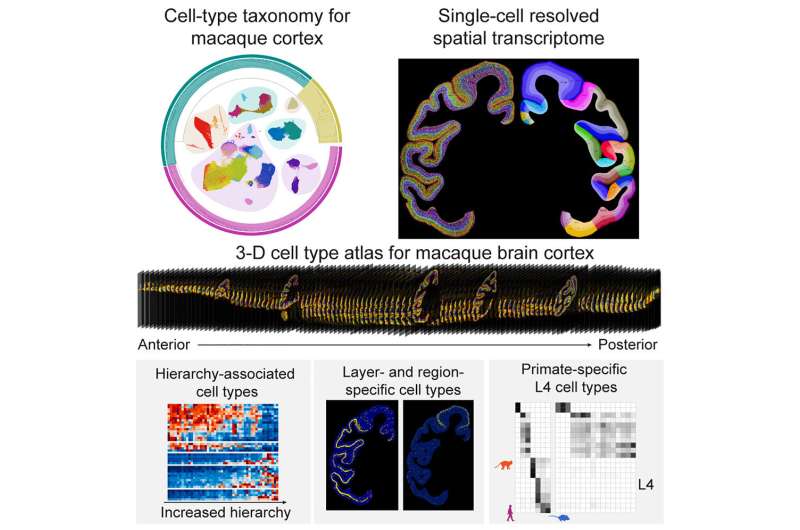This article has been reviewed according to Science X's editorial process and policies. Editors have highlighted the following attributes while ensuring the content's credibility:
fact-checked
peer-reviewed publication
trusted source
proofread
Scientists map single-cell spatial distribution atlas of macaque cortex

A team of nearly 100 scientists recently mapped the cell-type taxonomy in the macaque cortex and revealed the relationship between cell-type composition and various primate brain regions by using the self-developed spatial transcriptome sequencing technology Stereo-seq and snRNA-seq technology, which provides a molecular and cellular basis for further investigation into neural circuits.
The study was published in Cell.
Primates have a vast number of neurons that form complex and intricate neural circuits supporting advanced cognition and behavior. Disruptions in these cells and circuits can lead to various brain disorders. Understanding the composition and spatial distribution of cells in the brain, as well as the relationships between them, is a fundamental question in neuroscience, comparable to the periodic table in chemistry, the world map in geographic discoveries, or the DNA base sequence discovered through human genome sequencing.
Compared to other species, primates, including macaques as the closest animal model to humans, have higher cognitive and social abilities, as well as larger cortices and more cell types. For example, the macaque brain, with over six billion cells, can be classified into hundreds of cell types based on their molecular, morphological, or physiological features, and their spatial distribution spans hundreds of distinct brain regions.
Deciphering the composition and spatial distribution patterns of cell subtypes in the cortex is crucial for understanding the organizational principles of primate brains.
In this study, scientists utilized a newly developed large field-of-view spatial transcriptome method called Stereo-seq, and an independently developed method to prepare centimeter-scale thin slices of the macaque brain for the experiments.
By combining large-scale single-cell transcriptome analysis, they obtained a comprehensive three-dimensional single-cell atlas of the entire cortex of the crab-eating macaque, providing a guide for systematic analysis of cell-type distribution specificity and regional specificity within the cortex, as well as molecular features.
Additionally, scientists found that glutamatergic neurons, GABAergic neurons, and non-neuronal cells exhibited distinct cortical and regional specificity in their distribution throughout the cerebral cortex. Interestingly, there was a significant correlation between the cell-type composition and the hierarchical organization of brain regions in the visual and somatosensory systems.
Brain regions at the same hierarchical level tended to have similar cell-type compositions, revealing the relationship between cell composition and brain region structure.
Furthermore, through cross-species comparison with publicly available single-cell data from the human and mouse brains, scientists identified glutamatergic neuron cells specific to primates, which are predominantly located in the layer 4 and highly express genes associated with human diseases, including FOXP2, DCC, and EPHA3.
This study generated a comprehensive dataset of single-cell and spatial transcriptomics for the entire macaque cerebral cortex, providing an important data resource for future research. The data is now publicly available at https://macaque.digital-brain.cn/spatial-omics.
In the future, the team will continue to focus on the mechanisms and target development of brain diseases, brain cell and structural evolution, and cellular and molecular mechanisms of brain function.
More information: Ao Chen et al, Single-cell spatial transcriptome reveals cell-type organization in the macaque cortex, Cell (2023). DOI: 10.1016/j.cell.2023.06.009





















